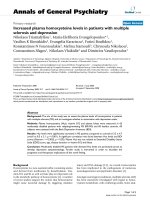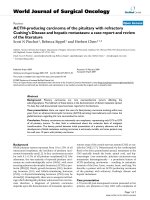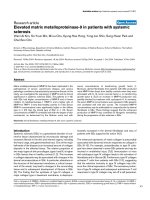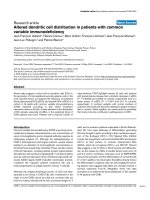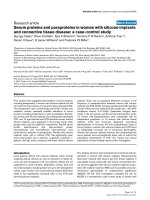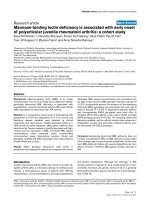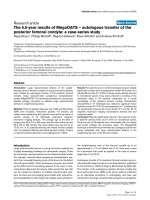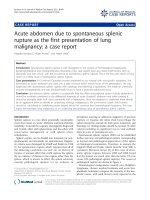Báo cáo y học: "Ruptured ovarian cystic teratoma in pregnancy with diffuse peritoneal reaction mimicking advanced ovarian malignancy: a case report" ppt
Bạn đang xem bản rút gọn của tài liệu. Xem và tải ngay bản đầy đủ của tài liệu tại đây (503.18 KB, 4 trang )
BioMed Central
Page 1 of 4
(page number not for citation purposes)
Journal of Medical Case Reports
Open Access
Case report
Ruptured ovarian cystic teratoma in pregnancy with diffuse
peritoneal reaction mimicking advanced ovarian malignancy: a case
report
Sachchidananda Maiti*
1
, Zamurrad Fatima
2
, ZK Anjum
3
and RE Hopkins
4
Address:
1
Department of Obstetrics and Gynaecology, St Mary's Hospital, Manchester M13 0JH, UK,
2
Department of Obstetrics and Gynaecology,
Royal Bolton Hospital, Bolton, UK,
3
Department of Obstetrics and Gynaecology, Royal Oldham Hospital, Oldham OL1 2JH, UK and
4
Women
Health Directorate, Royal Bolton Hospital, Bolton, UK
Email: Sachchidananda Maiti* - ; Zamurrad Fatima - ; ZK Anjum - ;
RE Hopkins -
* Corresponding author
Abstract
Introduction: This case illustrates the unusual complication of granulomatous peritonitis
following rupture of a dermoid cyst in pregnancy resembling disseminated ovarian carcinoma. To
the best of the authors' knowledge, this is the first report of this complication during advanced
pregnancy in the literature.
Case presentation: A dermoid cyst ruptured during surgical removal in the second trimester of
pregnancy in a 27-year-old primigravida. Postoperatively the patient suffered pulmonary embolism
and leakage of sebaceous material through the abdominal wound. She gradually developed
significant abdominal distension, gastrointestinal symptoms and lost more than 8 kg of weight in the
12 weeks postoperatively. The baby was delivered at 31 weeks by a technically challenging
caesarean section owing to severe dense adhesions obscuring the uterus. Bowel resection was
performed for suspected malignant infiltration and adhesion causing obstruction. She had a
protracted convalescence with an ileostomy and mucus fistula. Histology confirmed granulation
without malignancy. One year following the surgical treatment, she had recovered well and was
planning her next pregnancy.
Conclusion: Although granulomatous peritonitis following rupture of a dermoid cyst is very rare,
awareness is the key to diagnosis and appropriate management. Per-operative frozen section may
be helpful.
Introduction
Mature cystic teratoma (dermoid cyst) is one of the most
common benign ovarian neoplasms discovered during
pregnancy (24–40%) [1,2]. They may be responsible for
complications such as torsion, rupture and obstruction
during labour. Rupture is rare, but once it has occurred it
can cause complications such as chemical or granuloma-
tous peritonitis mimicking advanced ovarian malignancy
[3-5]. This case illustrates the unusual complication of
granulomatous peritonitis following rupture of a dermoid
cyst in pregnancy resembling disseminated ovarian carci-
noma. To the best of the authors' knowledge, this is the
first report of this complication during advanced preg-
nancy in the literature.
Published: 12 June 2008
Journal of Medical Case Reports 2008, 2:203 doi:10.1186/1752-1947-2-203
Received: 9 September 2007
Accepted: 12 June 2008
This article is available from: />© 2008 Maiti et al; licensee BioMed Central Ltd.
This is an Open Access article distributed under the terms of the Creative Commons Attribution License ( />),
which permits unrestricted use, distribution, and reproduction in any medium, provided the original work is properly cited.
Journal of Medical Case Reports 2008, 2:203 />Page 2 of 4
(page number not for citation purposes)
Case presentation
A booking ultrasound scan at 13 weeks gestation in a 27-
year-old primigravida showed an 11 × 9 × 10 cm smooth-
walled, mixed echogenic mass in the pouch of Douglas
(POD) suggesting a dermoid cyst and a viable singleton
intra-uterine pregnancy. A repeat scan four weeks later
showed an increase in the size of the cyst of 1 cm in each
dimension. CA-125 assay was within the normal limits in
pregnancy. Alpha-foetoprotein (AFP) was not tested
owing to the difficulty in interpretation during pregnancy.
Following extensive discussion of different treatment
options and timings, the patient opted for surgical
removal. The left ovary together with the cyst was
removed at 18 weeks of pregnancy. The cyst was impacted
in the pelvis owing to the gravid uterus and unfortunately
it ruptured during removal. The peritoneal cavity was
washed meticulously with 0.9% saline solution. In view
of the almost definite clinical diagnosis of an ovarian der-
moid cyst, the peritoneal fluid was not sent for cytology.
The right ovary was examined per-operatively and looked
clinically normal. Histology of the cyst confirmed the
diagnosis of a mature cystic teratoma (figure 1). The
patient was discharged on the sixth postoperative day. She
presented again at 20 weeks gestation with abdominal
pain, breathlessness and generalised malaise. Investiga-
tions were performed including a VQ (ventilation and
perfusion) scan that was highly suggestive of pulmonary
embolism. She was treated with low-molecular-weight
heparin. She continued to have episodes of abdominal
pain and fluctuating temperature. The white cell count
range was 9–19 × 10
9
/l and the C-reactive protein range
was 76–163.4 ng/dL. Repeated bacteriological cultures
were negative.
A magnetic resonance imaging (MRI) scan showed a col-
lection of fluid occupying the POD and subsequently a
subcutaneous collection was found during an ultrasound
scan. She was treated with antibiotics empirically. Seven
weeks following her initial surgery, she developed painful
induration of the wound. She underwent wound explora-
tion that revealed copious, thick, sebaceous-type material
tracking extra-peritoneally up to the costal margin and
umbilicus. Bacterial culture was again reported to be neg-
ative.
She developed dependent oedema, abdominal disten-
sion, intermittent vomiting and significant weight loss
despite advancing pregnancy. In view of the patient's con-
tinuing deterioration and significant psychological dis-
tress, it was decided to deliver the baby.
She underwent an elective caesarean section at 31 weeks
gestation following a course of antenatal steroids for foe-
tal pulmonary maturation. A caesarean section was per-
formed under epidural anaesthesia in the presence of a
general surgeon. The anterior abdominal wall was mor-
bidly adherent to the uterus making identification of the
uterus virtually impossible. Eventually the 'lower seg-
ment' was exposed with the fundus remaining obscured
by the dense adhesions. The caesarean section was per-
formed with a J-shaped incision. The baby was delivered
in good condition. The patient underwent general anaes-
thesia following delivery. There were diffuse adhesions
with the bowel adhered to the uterine fundus and lower
part of the pelvis. There were large lumps of possible gran-
ulation tissue on the bowel clinically mimicking malig-
nancy. The bowel was compromised with adhesions
producing kinking and bowel stasis. About 85 cm of the
ileum and 45 cm of the caecum and colon involved with
the mass suggesting infiltrating malignancy were resected
by colorectal surgeons. The abdominal wall, rectus mus-
cles, sheath and bowel were infiltrated by sebum-like
material. Following extensive exploration and drainage,
the patient was left with a mucus fistula on the left side of
the abdomen and an ileostomy on the right side. Histol-
ogy of the specimen confirmed granulation and inflam-
mation consistent with granulomatous peritonitis
without any evidence of malignancy (figure 2). She suf-
fered further wound breakdown and developed a small
bowel fistula through the operative wound. She also
developed anaemia, hypoproteinaemia, bilateral pedal
oedema and intermittent episodes of abdominal pain
with dyspnoea. A computed tomography (CT) scan
showed a homogenous collection in the POD. An attempt
to drain this possible collection vaginally was not success-
ful. In view of her continuing pain and poor nutritional
Histological slide showing lining of the cyst, skin and adipose tissue confirming the diagnosis of a dermoid cystFigure 1
Histological slide showing lining of the cyst, skin and
adipose tissue confirming the diagnosis of a dermoid
cyst.
Journal of Medical Case Reports 2008, 2:203 />Page 3 of 4
(page number not for citation purposes)
status, advice was sought from a tertiary referral centre.
Discussions and journal searches suggested that this rare
condition settles spontaneously and steroids might be of
some help. In an experimental model with rats, a massive
granulomatous reaction induced by intra-peritoneal inoc-
ulation of starch was significantly reduced when pred-
nisone at a dosage of approximately 1 mg/kg orally daily
was commenced two weeks before inoculation. Therapy
started when the starch was inoculated had only a minor
effect on this response, but if commenced two weeks after
inoculation, it failed to ameliorate the granulomatous
reaction [6].
Over the following six weeks (one year after her initial sur-
gery), her condition improved both physically and men-
tally. The inflammatory markers returned to normal. She
is presently thinking about going back to work and the
possibility of conceiving again.
Discussion
The word teratoma is derived from the Greek word teraton,
meaning monster, and was used initially by Virchow in
the first edition of his book on tumours, which was pub-
lished in 1863 (see [2]). Since mature cystic teratomas are
composed of all three germ cell layers, the term 'dermoid'
is a misnomer. Mature cystic teratomas are thought to
arise from primordial germ cells. This theory is supported
by the distribution of these tumours along the lines of
migration from the yolk sac to the primitive gonad. The
majority of these tumours occur during the reproductive
years providing further support for the germ cell theory
[2]. Benign cystic teratoma (BCT) is the most common
benign ovarian neoplasm comprising 10–15% of all ovar-
ian tumours. It occurs at all stages of life, the majority of
cases being diagnosed between 20 and 30 years of age [4].
This fact makes it the most common tumour during preg-
nancy (22–40% of all ovarian tumours) [4]. In pregnancy
the risk of complications increases significantly including
rupture, torsion, infection and malignant degeneration.
As BCT has a tendency to remain in the confines of the
true pelvis, it could lead to dystocia and obstructed labour
[4]. Treatment is surgical removal as soon as possible after
diagnosis to avoid complications. Ovarian cystectomies
or oophorectomies via laparoscopy or laparotomy are
options depending on the situation and expertise availa-
ble. All efforts should be made to avoid rupture or leakage
of cyst fluid during the operation. If it happens before or
during the operation, copious saline washing should be
performed to minimise chemical peritonitis and its seque-
lae [3,7,8]. When BCT is found incidentally in the first tri-
mester of pregnancy, surgical removal should be
performed at 14–16 weeks of gestation to avoid the risk of
damage to the corpus luteum. If diagnosis of BCT occurs
at 16–22 weeks, surgery should be performed as soon as
possible. If it is first discovered after 22 weeks of preg-
nancy, the treatment may be deferred until delivery [4].
Over 200 cases of BCT in pregnancy have been reported in
the literature and many of them ruptured spontaneously
or iatrogenically. In a review of 47 cases, Kocak et al [9]
reported that during cyst extraction, minimal spillage
occurred in 42.5% of cases and none developed chemical
peritonitis.
Clement et al [7] and Achtari et al [8] reported chemical
peritonitis following cystic fluid spillage. The patients
needed further surgeries to treat the complications. Two
other case reports by Suprasert et al [4] and one by
Phupong et al [5] reported a diffuse peritoneal reaction
mimicking advanced ovarian malignancy where full surgi-
cal staging was performed. Postoperative histological
examination revealed BCT and chronic granulomatous
peritonitis. A conservative approach was adopted and
patients were free of symptoms without further treatment
at 12 months [1,5]. The incidence of chemical peritonitis
after rupture and leakage of cystic fluid in the peritoneum
is less than 0.5% (see [2]). The incidence of chronic gran-
ulomatous peritonitis after rupture or leakage of cystic
fluid is also extremely rare. In granulomatous peritonitis
after ruptured ovarian teratomas, numerous nodules of
mature glial tissue implant on a widespread area of the
peritoneum [10].
Ruptured BCT of the ovary mimicking gynaecological
malignancy is uncommon and could be misdiagnosed
[5]. Intra-abdominal peritoneal seedlings, adhesions and/
or masses are frequent sequelae. In most such cases,
abdominal seedlings are essentially of mature neuroglial
elements and long-term survival rate is good. Recognition
of a dermoid tumour associated with glial seedling is
important to avoid unnecessary debulking surgery. Fol-
Histological slide showing chronic granulomatous reactionFigure 2
Histological slide showing chronic granulomatous reaction.
Publish with BioMed Central and every
scientist can read your work free of charge
"BioMed Central will be the most significant development for
disseminating the results of biomedical research in our lifetime."
Sir Paul Nurse, Cancer Research UK
Your research papers will be:
available free of charge to the entire biomedical community
peer reviewed and published immediately upon acceptance
cited in PubMed and archived on PubMed Central
yours — you keep the copyright
Submit your manuscript here:
/>BioMedcentral
Journal of Medical Case Reports 2008, 2:203 />Page 4 of 4
(page number not for citation purposes)
lowing postoperative adhesions, fibrous bands or obstruc-
tions, conservative management seems to have a good
prognosis.
Conclusion
Although granulomatous peritonitis following rupture of
a dermoid cyst is very rare, awareness is the key to diagno-
sis and appropriate management. Peroperative frozen sec-
tion may be helpful. Optimal management avoids
unnecessary repeated major surgeries and provides a good
long-term outcome with minimal complications.
Competing interests
The authors declare that they have no competing interests.
Consent
Written informed consent was obtained from the patient
for publication of this case report. A copy of the written
consent is available for review by the Editor-in-Chief of
this journal.
Authors' contributions
SM and ZF collected the data, and designed the case report
with significant contributions from ZKA and REH, SM for-
matted and finalised the draft. All authors read and
approved the final manuscript.
Acknowledgements
The authors wish to express their gratitude to the patient Ms CS.
References
1. Comerci JT Jr, Licciardi F, Bergh PA, Gregori C, Breen JL: Mature
cystic teratoma: a clinicopathologic evaluation of 517 cases
and review of the literature. Obstet Gynecol 1994, 84:22-28.
2. Peterson WF, Prevost EC, Edmunds FT, Hundley JM Jr, Morris FK:
Benign cystic teratomas of the ovary; a clinico-statistical
study of 1,007 cases with a review of the literature. Am J Obstet
Gynecol 1955, 70:368-382.
3. Stuart GC, Smith JP: Ruptured benign cystic teratomas mimick-
ing gynecologic malignancy. Gynecol Oncol 1983, 16:139-143.
4. Suprasert P, Khunamornpong S, Siriaunkgul S, Phongnarisorn C, Siri-
aree S: Ruptured mature cystic teratomas mimicking
advanced stage ovarian cancer: a report of 2 cases study. J
Med Assoc Thai 2004, 87(12):20041522-1525.
5. Phupong V, Sueblinvong T, Triratanachat S: Ovarian teratoma
with diffused peritoneal reactions mimicking advanced ovar-
ian malignancy. Arch Gynecol Obstet 2004, 270:189-191.
6. Cade D, Ellis H: The peritoneal reaction to starch and its mod-
ification by prednisone. Eur Surg Res 1976, 8:471-479.
7. Clement D, Barranger E, Benchimol Y, Uzan S: Chemical peritoni-
tis: a rare complication of an iatrogenic ovarian dermoid cyst
rupture. Surg Endosc 2003, 17:658.
8. Achtari C, Genolet PM, Bouzourene H, De Grandi P: Chemical
peritonitis after iatrogenic rupture of a dermoid cyst of the
ovary treated by coelioscopy. Apropos of a case and review
of the literature. Gynakol Geburtshilfliche Rundsch 1998,
38(3):146-150.
9. Kocak M, Dilbaz B, Ozturk N, Dede S, Altay M, Dilbaz S, Haberal A:
Laparoscopic management of ovarian dermoid cysts: a
review of 47 cases. Ann Saudi Med 2004, 24:357-360.
10. Ronnett BM, Seidman JD: Mucinous tumors arising in ovarian
mature cystic teratomas: relationship to the clinical syn-
drome of pseudomyxomaperitonei. Am J Surg Pathol 2003,
27:650-657.
